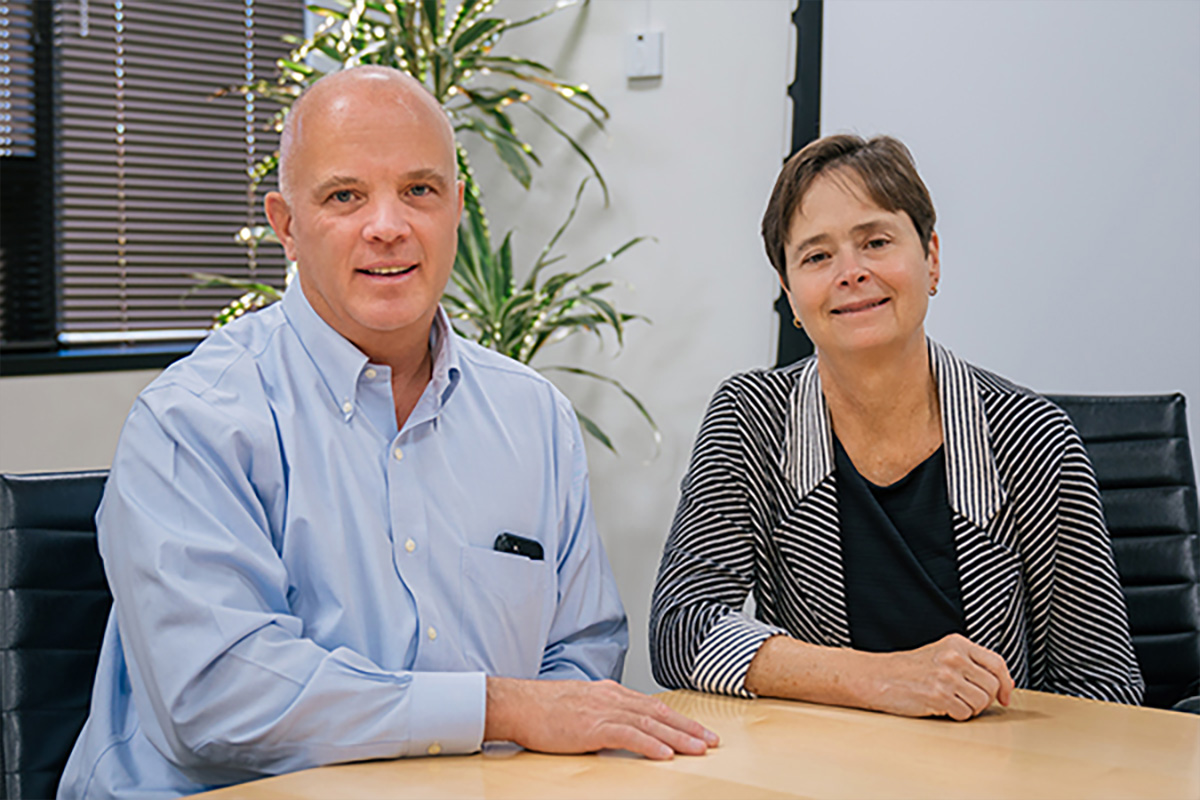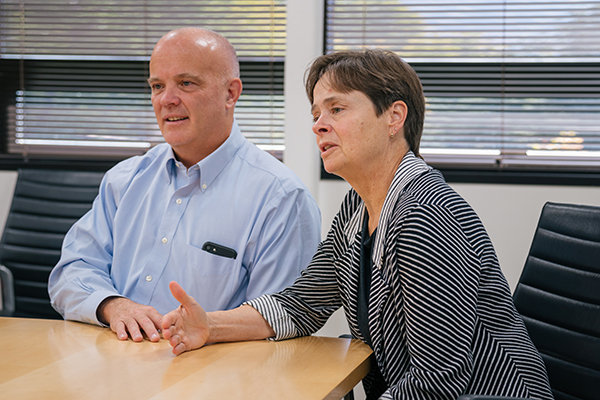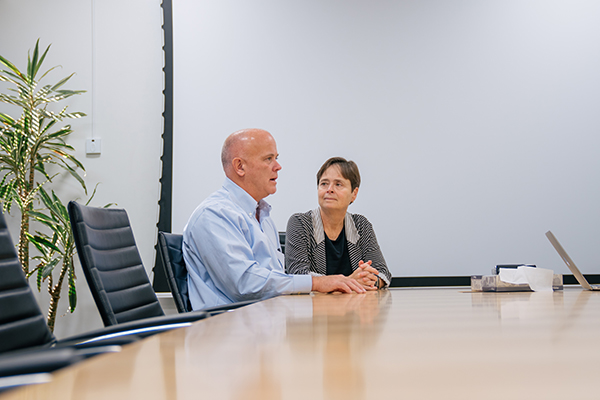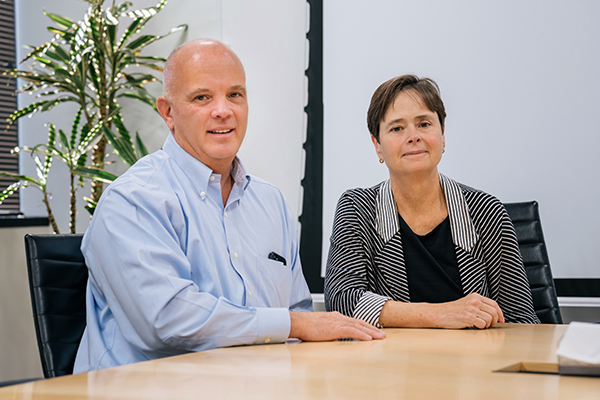New Leadership Infused with Hands-On Experience

Andy Theurer, CPA
Chief Financial Officer
Senior Vice President, Finance
Secretary, ARUP Laboratories Board of Directors (17 yrs.)
Author of articles on laboratory economics
Sherrie Perkins
Director of Hematopathology
Interim Department Chair, Department of Pathology
Division Chief of Clinical Pathology
Director of R&D Institute
Member of Executive Management Team (10 yrs.)
Tenured Professor of Pathology, U of U
Author of 200 + journal articles and 70 book chapters on hematopathology
This past August, not one, but two experienced ARUP veterans were selected to lead the company forward. Sherrie Perkins, MD, PhD, became the new CEO, and Andy Theurer, CPA, became the new president. With more than 50 years of ARUP experience between them, their breadth and depth of expertise runs wide and deep, as does their loyalty to a company that they have watched grow and evolve throughout the years. In the following Q & A, they share their thoughts on ARUP and each other, what’s ahead, and in the process, reveal their leadership style.
What does Andy bring to the table in his role as president?
S—Andy brings a wealth of experience; he’s been here 27 years, just like I have. His deep knowledge of finance and business are indispensable, as well as his thorough understanding of what makes ARUP unique as a business. While I certainly know medicine and technology, the business side of ARUP has not been a big focus of my past roles. I can really rely on Andy’s expertise.
And Sherrie, what does she bring as CEO?
A—At the heart of ARUP is medicine. Sherrie knows medicine and the lab industry. She is internationally known for her pathology expertise, has run the R&D department here, and has been the chief medical director. She knows academics and the importance of that differentiator for ARUP. Sherrie understands the synergies that are created by merging an academics and business enterprise, and she sees how to get the most out of it. While all these skills make her a great choice in leading this company, she also knows what she doesn't know and will rely on the expertise of others.
“Sherrie understands the synergies that are created by merging an academic and business enterprise, and she sees how to get the most out of it. While all these skills make her a great choice to lead thiscompany, she also knows what she doesn’t know and will relyon the expertise of others.”
Thoughts on being ARUP’s first female CEO?
S—I’ve always been at the forefront and cracked a lot of pink glass ceilings on the way up. But honestly, I don’t see myself so much as being a woman in this role, but rather being someone who really cares about ARUP. I do think it is a really exciting opportunity. I have two daughters, and I want to be a role model for them and their friends, and that means a lot to me. I’m really looking forward to the challenge.
What’s next?
S—We will continue to focus on being a partner in health systems and provide the best patient care through our testing and with other tools we innovate. This will keep us at the leading edge of lab medicine. We’ve learned a lot over the last four to five years with our changes in leadership, and we’re ready to move on and continue growing.
A—We’ve been able to study what’s really driving our growth. We’ve grown 30 percent over the last three years, and that growth is continuing and gaining even more traction. Our competitors have not experienced that kind of growth; they grow through acquisitions of other companies. When you tease out the acquisitions, their organic growth has been flat.
Speak to ARUP’s growth and its challenges?
A—Our growth will continue to come from new tests and developments in our core business: chemistry, immunology, and infectious disease. If we can successfully help to make our client jobs easier, they will reward ARUP with their loyalty. Both quality testing coupled with exceptional service are part our roots.
S—Our focus is on maintaining and strengthening the core. We realize we’re going to come under tremendous price pressures as our clients deal with regulation changes such as PAMA and other factors. With reimbursement cuts, we need to figure out how to strengthen our core and be more efficient so that we can partner with clients to provide them lower prices, which will make health systems healthier.
A— Strengthening the core means standardizing and automating wherever we can. This concept is not new to ARUP. The Core lab and specimen handling and storage system areas are good examples. Now we are working on standardizing and automating within the laboratory itself to strengthen our core areas. This will allow us a much higher capacity so we can manage the increasing workload. It will also free up our employees from mundane tasks allowing them to focus on more sophisticated processes. This should make their jobs more meaningful and rewarding; they won’t get stuck doing the repetition part that automation can do.
S—Automation and standardization will also cement the high quality ARUP is known for; it’s much easier to be consistent when you have very standardized practices and one way of doing things.
This is our focus for the next three to five years. It’s a very large initiative, and other platforms will come in under this. The plan is for all of this to coalesce with the new building we’re adding to accommodate growth.

A—Focusing on the core will produce healthy margins which can then be used for innovation efforts, for example, next generation sequencing (NGS). PCR and Mass Spectrometry are part of ARUP’ core testing but years ago, they were cutting-edge. NGS is on the cutting edge now.
S—So now we’ll invest in an NGS genetic lab and really focus on keeping ARUP at the forefront of esoteric testing. As a company, we need to embrace a balance between pursuing cutting-edge developments and sticking to our core.
How is our academic connection important?
S—It’s essential. It’s one of our differentiating factors both in helping us to understand what our clients are going through [ARUP operates several of the hospital’s labs] and provides for collaboration in academics. It helps us to really remain on the cutting edge of science.
A—Let’s not forget that we emerged out of the University Hospital and the Department of Pathology. The hospital continues to be a sister company and a perfect incubator for us to try new developments, such as in utilization management, before taking them to our other clients.
Talk about collaborations with the University of Utah? Huntsman Cancer Institute (HCI)?
S—Many of our medical directors are involved in HCI research and patient care, attending tumor boards and interacting with clinicians daily. The technologies we have here at ARUP help drive the research. Being a part of this research keeps us on the leading edge in cancer developments. For example, we’ve been asked to look at doing next generation sequencing to identify some new targets [cancer biomarkers] and working more closely with people in HCI’s hematology section. There are also multiple interactions that are going on with the anatomic pathologists in the areas of breast cancer and other neoplasms.
Some of the other collaborations happening in other areas of the University include the Scientific Computing Institute, the Utah Genome Project, as well as the Engineering and Business schools. This cross pollination helps us to tap into the newest things happening in these fields as well as interact closely with experts not available to many other people in the industry. Again, this is a differentiator for us from other labs.
A—We’ve also collaborated with the Department of Engineering in the past to help us build some of our automation and track systems. We continue to interact with the bioinformatics in hopes to find better ways to integrate information into the EMR. The business school has talked to us about different models of thinking about innovation, institutional organization, and variety of topics that have helped shape us.
Tell us about next generation sequencing at ARUP?
S—If you look at all the reference labs and academic labs across the United States and Europe, NGS is going to be playing an essential role in patient care. ARUP is positioning itself within a market that has not been particularly well established but moving forward will be essential for remaining at the leading edge of patient care, particularly in the areas of genetic disorders, as well as cancer.
“We know that the laboratory drives the rest of medical care. While lab costs account for only about 3 percent in medicine, laboratory test results influence more than 70 percent of medical decisions. Using the right test, for the right patient, at the right time can help reduce downstream costs.”
We’re building the NGS [Genomics] lab out in multiple ways. First of all, we are developing test panels that allow us to use a standardized approach, no matter what the specific genes. These panels will focus on cancer and genetic abnormalities in hereditary disorders. These NGS panels will allow for more standardized workflows because everything will be done in the same way. Right now, we have 60 NGS tests, and every single one is done in a slightly different way, and that makes for a lot of challenges.
A—This is driving our strategy. While there are many small companies built around one test, ARUP will be able to offer specific tests with these NGS panels while maintaining standardization. In other words, clients can set up a specific panel to meet their needs and ARUP will not have to change our process for each panel. We will run one standard “uber panel” greatly minimizing complexity. And that is something we can scale.
The new NGS lab is being built on a very automated line, including extraction and amplification tasks; there’s going to be minimum touches. This will allow our medical experts to focus on interpreting tests rather than worrying how things are being run.
Who was an important mentor?
S—Without question, Carl Kjeldsberg [ARUP’s co-founder and former CEO]. I originally came to Utah from Washington University in St. Louis to do a fellowship with Carl at the University of Utah. I wanted to stay on just because it was such a great opportunity to work with a giant of hematopathology, and we’ve maintained close mentoring ties throughout the evolution of his career.
He taught me the importance of work-life balance. I remember one weekend working on a paper and he came by and said, “Sherrie go home and be with your daughters and husband. This will still be here when you come in on Monday.” He also instilled in me a love for medicine, especially hematopathology, and the importance of people. He taught me that if you take care of people, the people will take care of the business.
And your mentor, Andy?
A—Carl mentored me as well. For eight years, I was his CFO [chief finance officer], and that relationship has continued. He taught me to not take myself too seriously. He could be so focused, yet have a sense that everything will work out. I remember being in a pretty intense meeting, and he leans over and asks me how’s my water skiing coming along—a passion of mine. It not only lightened things up, but it showed that he was interested in me as a person He was always interested in people at ARUP and learning about them. That’s one of the things that I've taken away from Carl: Get to know the people here better because they make this company work day in and day out.
He is still my mentor. In this new role, I’ve asked him to continue mentoring me. He’s already done his own 360 analysis of me and has been quite frank in how I can improve.
S—Continual improvement is part of the culture here that he really instilled. It was always about continued innovation and thinking about what’s next and how to do better and better.
Anticipated challenges ahead?
S—One of the major challenges that I think is coming to the entire healthcare industry, and particularly the lab industry, is the issue of reimbursement. We see this particularly in Medicare, which will drive the third-party reimbursement, with PAMA [Protecting Access to Medicare Act ] and other cuts. Over the next three years, the industry is looking at cuts of up to 30 percent of reimbursements.
“We’ve always been about education and sharing our expertise in lab medicine. We can share knowledge with our clients to help them understand industry changes and how to become more efficient.”
This is really going to severely impact many of our clients because the margins are so fine, so we have to support them by looking at ways to do our testing better, faster, and more efficiently so we can cut costs without compromising quality. We can help our clients become more efficient through utilization management efforts.
We know that the laboratory drives the rest of medical care. While lab costs count for about only 3 percent in medicine, laboratory test results influence more than 70 percent of medical decisions. Using the right test, for the right patient, at the right time can help reduce downstream costs in the healthcare system, such as reducing the length of stay in the hospital or eliminating a medication that the patient is not responding to.
A—Another challenge is attracting good talent and keeping them in a strong economy. With our growth, we are looking at new ways to attract and retain employees that includes analyzing our benefits package, reworking the compensation package, and focused on keeping our people healthy and happy just to name a few.
How can we support our clients for the future?
S—We’ve always been about education and sharing our expertise in lab medicine. We can share knowledge with our clients to help them understand industry changes and how to become more efficient. Continuing to partner with our clients and provide new UM [utilization management] efforts on how to provide the best care in the most cost-effective ways. The Illumicare ribbon is an example of a recent tool that will help our clients in this area. Our aim is to drive excellence in healthcare with all of our clients.
A—We believe healthcare is best delivered closest to the patient, so we pursued partnerships with our clients to support their efforts to be the principal healthcare providers in the communities they serve. We helped our clients better service physician office labs in their communities and enabled them to refer tests to us that they couldn’t do.
How will ARUP be quicker, more nimble, in the marketplace?
A—The way to become quicker and more nimble is to keep processes simpler, which means standardizing. We’re doing this and it will be our focus for the next few years. As we continue to grow, this will be an important accomplishment for ARUP because the bigger you get, the harder it is to be nimble without standardizing and simplifying our processes.
Does the academic element inhibit the ability to act fast?
S—Yes. On one hand, our academic ties may make us less agile, but it is also what keeps us on the leading edge of what we do. It is this balance between academics and our business mission that has made us so successful.
A—ARUP’s founding fathers realized that there needed to be more agility than what you typically find in a complete academic setting. This is the “enterprise” part of ARUP as it developed out of the U of U’s Department of Pathology. They realized business and strategy decisions needed to happen faster than what you’d find at a university.
“The reputation and reach of ARUP has changed. I remember going on a couple of sales calls early on, and people would act like, ‘Utah? Do planes go there?’ Now, ARUP has become well known and incredibly respected coast to coast.”
You’ve been at ARUP a long time. What are some notable changes you’ve witnessed here?
A—The financial strength of ARUP. When I came here, we were operating on a financial thread. Every two weeks we borrowed the maximum amount possible just to make payroll; we would take large vendor checks and put them in a drawer until we had enough money in the bank for them to clear. For a number of years, the financial condition was slim. Since then, we’ve grown the business by 20-fold. With that, we’ve become better and more efficient, which continues to drive our economic strength. Now we can make decisions quickly, knowing we have the financial backing to support those decisions.
S—The reputation and reach of ARUP has changed. I remember going on a couple sales calls early on, and people would be, “Utah? Do planes go there?” Now, ARUP has become well known and incredibly respected coast to coast. Our reputation for quality, our medical directors, and the U of U have really cemented us as being a leader in this field.
What personally prepared you for this job?

A—The many challenges I’ve faced while working here at ARUP from turning almost disastrous tax audits and assessments into complete tax exemption, to the potential sell of ARUP and challenging board members. They’ve all helped shape me and my understanding of what is best for ARUP. Working with the people here has made me realize that we can do great things and solve very complex problems as a team.
S—Throughout my career, I’ve always had my family’s support behind me, encouraging me to go for it. I’ve had great mentors who were willing to let me try and do things that weren’t really accepted when I first came here, and there were very few women in leadership positions at the University. I also think the strong teams we’ve been able to build here influenced me—helped give me the confidence that we can figure out hard problems together.

















 HOME
HOME